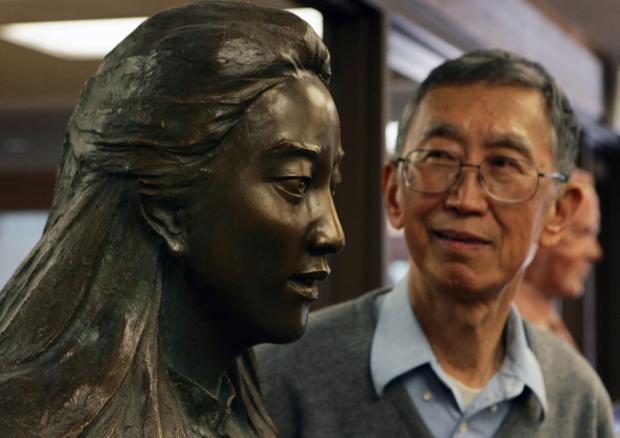Since her untimely death in 2004, the legacy of world-renowned Chinese-American author Iris Chang has lived on in the pages of her bestseller, “The Rape of Nanking.” But now that legacy has also found a home in a museum in China dedicated to her work.
Chang, a San Jose resident, took her own life in Los Gatos at age 36. Her book is internationally recognized as the most detailed Western account of the 1937 Nanking massacre, when the Japanese army brutalized thousands of Chinese soldiers and civilians during the Second Sino-Japanese War.
The elegant memorial hall honoring Chang opened last month in her ancestral home of Huai’an, Jiangsu province. Construction took two years, according to her mother, Ying-Ying Chang, a retired microbiology researcher who lives in San Jose.
Chang remembers her daughter as a diligent and passionate person who never gave up in her quest for the truth and the pursuit of social justice.

Shau-Jin Chang looks at a bust of his late daughter, Iris Chang, in the archive library
at the Hoover Institution at Stanford University.
“That really inspired me,” the author’s mother said. “And these are the things I hope inspire other people.”
Through the museum, she added, “I hope people will know who Iris was and why we memorialize her and what she did.”
Ying-Ying Chang and her husband, Shau-Jin, a retired physics professor, donated more than 100 pieces for the museum — everything from their daughter’s old books and letters to her clothing. The memorial is divided into six parts, each depicting a different aspect of Chang’s life. Designed by architect Qi Kang, the building’s exterior follows the style of China’s ancient Han Dynasty, according to her mother. It’s the first memorial to honor the late author and the second to commemorate the Nanking massacre.
Though Iris Chang was born in Princeton, New Jersey, she was deeply curious about Chinese history, according to her mother. She made trips to China to do research for her book and to interview elderly survivors of the massacre.
She also spent a significant portion of her career educating others about what took place during the Rape of Nanking and defiantly called on the Japanese to acknowledge the attack.
“I want the Rape of Nanking to penetrate into public consciousness,” Iris Chang said in a 1998 radio interview during a national book tour. “Unless we truly understand how these atrocities can happen, we can’t be certain that it won’t happen again.”
During the massacre — dubbed “the Forgotten Holocaust” — an estimated 300,000 Chinese civilians were bayoneted, machine-gunned or burned alive. Japanese troops raped tens of thousands of women and girls.
But the horrors did not begin and end there, scholars say. From the invasion of Manchuria in 1931 until their surrender in 1945, Japan engaged in germ warfare, slave labor, mass rapes and dissection of live bodies for medical research. Some scholars say 15 million Chinese died as the direct result of Japan’s invasion.
A significant movement among the Chinese to get Japan to apologize for World War II and the Nanking massacre has centered around Silicon Valley for decades. Chinese immigrants in the valley in the early 1990s founded the Cupertino-based Alliance for Preserving the Truth of the Sino-Japanese War, sparking a first-of-its kind campaign to make the world aware of what happened during Japan’s 14-year occupation of China.
.jpg)
As part of an exhibit at Stanford’s Hoover Institution in 2009, a video played continuously of an interview Iris Chang gave to a Canadian TV reporter. Chang’s parents, Ying-Ying and Shau-Jin Chang, watched as they toured the exhibit, titled “Shattered Peace: The Road to World War II.”
The Japanese government has never formally apologized for the war.
During a joint visit to Pearl Harbor with President Barack Obama in December, Japanese Prime Minister Shinzo Abe offered “sincere and everlasting condolences” to the victims but did not apologize.
The issue has been an uncomfortable one for some Japanese-Americans. As a state assemblyman in 1999, Mike Honda, a San Jose Democrat and former congressman who had spent the war years as a child in a U.S. internment camp for people of Japanese ancestry, won approval of a resolution calling on the Japanese government to say it was sorry for wartime atrocities.
But although Honda drew careful distinctions between modern-day Japan and the aggressor of the 1930s and 1940s, his resolution was opposed by fellow Democrat George Nakano, an assemblyman from Torrance who felt it was divisive and would foster ill will toward Japanese-Americans.
Ignatius Ding, a close friend of Iris Chang and a founder of the Cupertino-based Global Alliance for Preserving the History of WWII in Asia, worked with Chinese officials to design the museum.
Chang, he said, inspired the Chinese to become more open-minded, helping to create the more “open society” that exists in the country today.
“That’s a major, major thing,” he said. “The fact that they created a memorial for her, in her name … that never happens.”



